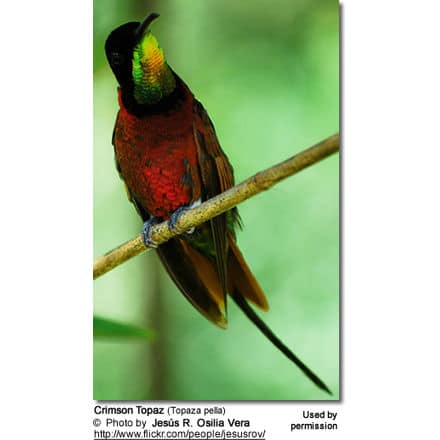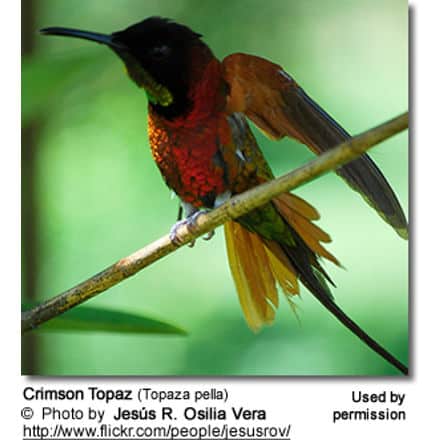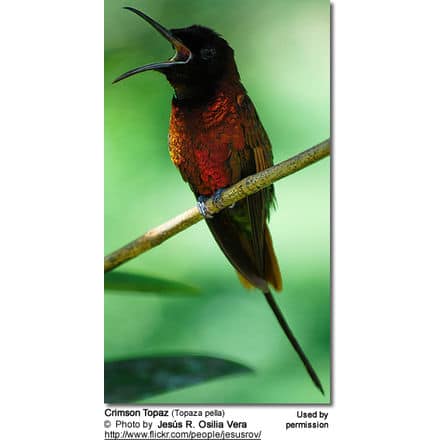Crimson Topazes
The Crimson Topazes (Topaza pella) is a resident (non-migratory) South American hummingbird that occurs naturally in Amazonian Brazil to the south of the Amazon River, in southern Venezuela and the Guianas.
Other (Common / Global) Names:
Other English (Common) Names: Topaz-throated Hummingbird, King Hummingbird, Beautiful or Inca Topaz.
Spanish: Topacio Candela de Cola Canela; Portuguese: beija-flor-brilho-de-fogo, Topazio-vermelho, topázio-vermelho; French: Colibri topaze; Italian: Colibrì topazio cremisi, Topazio cremisi; Russian: ????????? ???????; Germany: Rotnacken-Topaskolibri, Topaskolibri; Dutch: Topaaskolibrie; Czech: kolib?ík topasovohrdlý, Kolibrík topasový; Danish: Rød Pragttopas; Finnish: Punatopaasikolibri; Japanese: topaazuhachidori, topa-zuhachidori; Norwegian: Karmintopas; Russian: ????????? ???????-?????, ????????? ???????, ????????? ???????; Swedish: Karmosintopas
Subspecies
The subspecies can be identified by some differences in the coloration of their plumage, either more or less crimson (rose red) on the underplumage and the black coloration of the head.
- Topaza pella pella – Nominate Race (Linnaeus, 1758) – Range: Southern Venezuela (east Bolívar) and the Guianas to northern Brazil (Amapá).
- Topaza pella pampreta (Oberholser, 1902)
- Range: Eastern Ecuador (Suno, Napo River)
- Topaza pella microrhyncha (Butler, 1926)
- Range: North-central Brazil, along the south bank of the lower Amazon in the vicinity of Belém.
- Topaza pella pyra (Gould, 1846)
- Often considered a separate species, but its size and color patterns only suggest a geographical variation at subspecies level. Some individuals of the nominate form also have a glittering orange abdomen, thus resembling the pyra.
- Range: Southeastern Colombia, eastern Ecuador, and northeastern Peru to northwestern Brazil (Negro River) and south Venezuela in the Amazonas
- [Topaza pella smaragdulus] (Bosc, 1792)
- Proposed subspecies for birds found in the French Guiana, however, they cannot be physically differentiated from the nominate species
- Range: French Guiana
- Topaza pella pampreta (Oberholser, 1902)

Distribution / Range
The Crimson Topaz occurs naturally in Amazonian Brazil, in southern Brazil, French Guiana, Guyana, Colombia, Peru, Suriname, and Venezuela.
They inhabit lowland rainforests up to an elevation of approx. 1,700 feet or 500 meters. They are found high up in the canopy and in the ever-green forests along rivers and creeks. Very rarely they come down to the ground. So even though they are quite common within their range, they are not often seen.
They are mostly sedentary but may perform seasonal movements according to the flowering seasons within their range.
Description
The male is the largest hummingbird found in Brazil, and in the Andes, only the Giant Hummingbird is larger.
Sizes:
Males measure from 8.3 – 9 inches or 21 – 23 cm in length; however, this includes their long tail feathers which measure 4.7 – 5.1 inches or 12 – 13 cm. Males weigh between 0.4 – 0.5 oz or 10 – 14 grams. The straight, black bill is about 4 cm or 1.6 inches long.
The smaller females measure between 5.1 – 5.5 inches or 13 – 14 cm and weigh about 0.4 oz or 10 grams.

The adult male‘s most striking features are the two tail feathers next to the central feathers, which are much longer than the rest, curved, and crossed halfway down; as well as the metallic yellowish-green throat with a golden-brown to yellow sheen in the center, bordered by a black band. They have a mostly red plumage tinted orange and rose in various areas. The abdomen is red with a hint of rose to purple. His back is bright red. His upper tail feathers are golden green and his under tail feathers are bronze-green. The iridescence of its plumage is used during courtship or in defensive situations. His head is mostly a deep black. The wings are mostly brown with glossy crimson shoulders. Their flashy-colored plumage is used to attract females and to signal dominance.
They have dark brown eyes and orange-brown legs and feet.
The adult female is smaller than the male and she lacks the elongated tail feathers of the male. Her upper plumage is dark green and her under plumage is green with golden green edging. Her throat is green with crimson (rose-red) edges. Her central tail feathers are bronze-green; the next pair of feathers are violet; the other tail feathers are chestnut-colored. Her undertail feathers are glossy green.
Juveniles look like females. They attain their adult plumage in the second year.
Similar Species: The Crimson Topaz resembles the Fiery Topaz found to the west of its range. Some authorities consider the Fiery Topaz a subspecies of the Crimson Topaz.

Calls / Vocalizations
They make high-pitched chirps and whistles. Their contact or defense calls are often short. Their aggression/chase calls are described as a series of rapid chattering.
Nesting / Breeding
Topazes usually breed twice a year, and the breeding season varies according to the range. In Guiana, the first season usually starts in January and goes on until April, and the second is from July through November.
Hummingbirds in general are solitary and neither live nor migrate in flocks; and there is no pair bond for this species – the male’s only involvement in the reproductive process is the actual mating with the female.
During the breeding season, the male exposes his flashy-colored throat. The iridescence of its plumage is used in attracting the attention of females, or as a way to warn territorial intruders.
He will separate from the female immediately after copulation. One male may mate with several females. In all likelihood, the female will also mate with several males. The males do not participate in choosing the nest location, building the nest, or raising the chicks.
The female is responsible for building the cup-shaped nest out of pale-colored plant fibers, often of Bombax seeds, woven together and green moss on the outside for camouflage in a protected location in a shrub, bush, tree, or vines, about 10 – 26 feet (or 3 to 8 meters) above or near water. The small nest measures about half the length of the female and appears small compared to her. She lines the nest with soft plant fibers, animal hair, and feathers down, and strengthens the structure with spider webbing and other sticky material, giving it an elastic quality to allow it to stretch to double its size as the chicks grow and need more room.
The average clutch consists of two white eggs, which she incubates alone for about 14 to 23 days (the exact time is not known), while the male defends his territory and the flowers he feeds on. The young are born blind, immobile, and completely helpless. The chicks are black with a scarce pale grey down on the back.
The female alone protects and feeds the chicks with regurgitated food (mostly insects since nectar is an insufficient source of protein for the growing chicks). As is the case with other hummingbird species, the chicks are brooded only the first week or two and left alone even on cooler nights after about 12 days – probably due to the small nest size. The chicks leave the nest when they are about 21 days old, but will be cared for by the female for another 3 weeks. The offspring attains its adult plumage and reaches sexual maturity in the second year.

Hummingbird Resources
- Hummingbird Information
- Hummingbird Amazing Facts
- Attracting Hummingbirds to Your Garden
- Hummingbird Species
- Feeding Hummingbirds
Diet / Feeding
The males establish feeding territories which they defend by calling out to the intruders and flashing their bright colors towards them.
They primarily feed on nectar taken from a variety of brightly colored, scented small flowers of trees, vines, shrubs, and epiphytes found in the canopy of the forest.. They are often observed visiting the flowers of the Bromeliaceae and Ericaceae. In some areas (such as the Surinam), they forage near the ground.
They favor flowers with the highest sugar content (often red-colored and tubular-shaped) and seek out, and aggressively protect, those areas containing flowers with high-energy nectar. They use their long, extendible, straw-like tongues to retrieve the nectar while hovering with their tails cocked upward as they are licking at the nectar up to 13 times per second. Sometimes they may be seen hanging on the flower while feeding.
Many native and cultivated plants on whose flowers these birds feed heavily rely on them for pollination. The mostly tubular-shaped flowers actually exclude most bees and butterflies from feeding on them and, subsequently, from pollinating the plants.
They may also visit local hummingbird feeders for some sugar water, or drink out of bird baths or water fountains where they will either hover and sip water as it runs over the edge; or they will perch on the edge and drink – like all the other birds; however, they only remain still for a short moment.
They also take some small spiders and insects – important sources of protein particularly needed during the breeding season to ensure the proper development of their young. Insects are often caught in flight (hawking); snatched off leaves or branches, or taken from spider webs. A nesting female can capture up to 2,000 insects a day.
Males establish feeding territories, where they aggressively chase away other males as well as large insects – such as bumblebees and hawk moths – that want to feed in their territory. They use aerial flights and intimidating displays to defend their territories.



